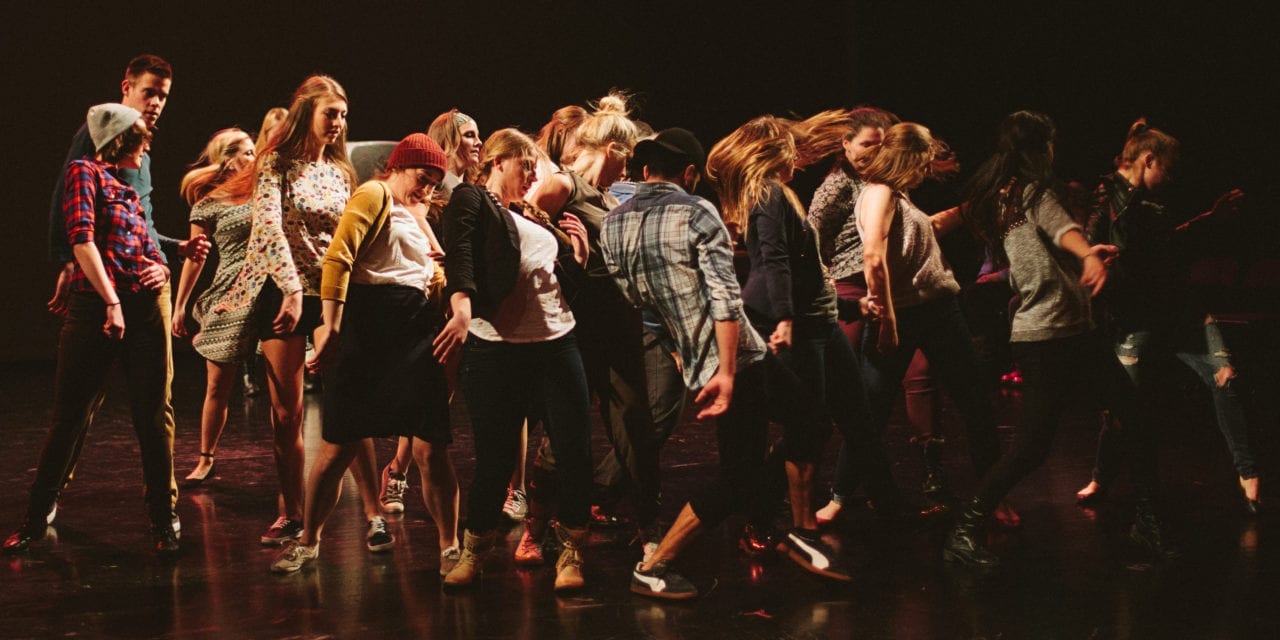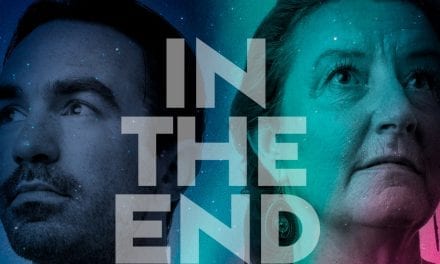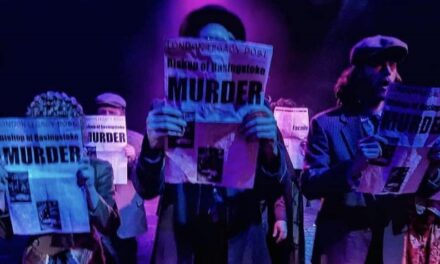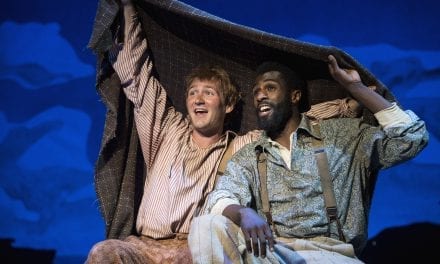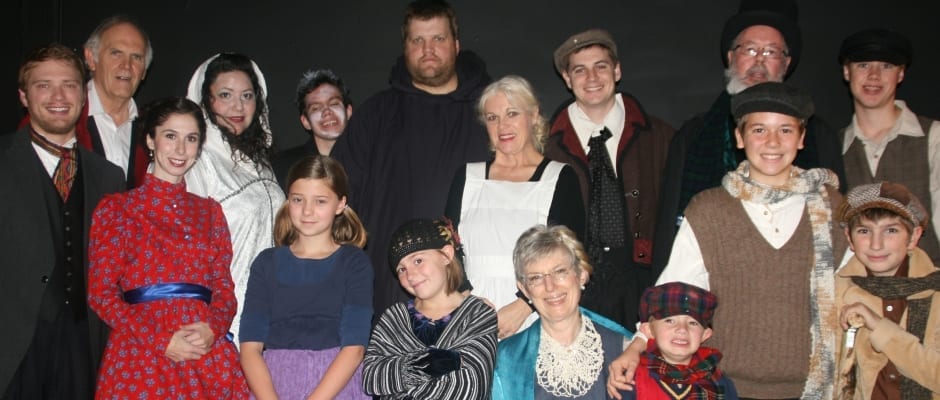SALT LAKE CITY — A couple years ago when I was in New York City, I had the opportunity to see the critically acclaimed immersive theatrical experience Then She Fell. Ever since then I have been captivated by immersive theatre and jumped at the chance to see Sackerson’s production of Sonder, an immersive dance theatre piece. Written, directed, and choreographed by Graham Brown, Sonder focuses around a loose story line that follows four friends, Warner (played by Jordan Simmons), Charlie (Eliza Tappan), Pascal (Shawnee Jo Haycock), and Marco (Francisco Aviña). The piece explores themes of death, loneliness, and the human experience in a unique and enchanting way.

Show closes April 8.
Sonder is performed in the old Historic Eagle’s Hall in downtown Salt Lake City, which the company has transformed into a theatre space. The space worked tremendously well for the particular work, featuring three floors with many rooms that are filled with trinkets, photos, and typical household objects. Exploring the intricacies of the building and the excellent design elements might have been the most satisfying aspect of the production. The use of many mirrors, pictures depicting life events, and an eclectic selection of various books produced an existential and contemplative feel. I delved into the exploration, discovering many treats that enhanced the production and my experience, such as photo albums, little notes tucked away in books, and used scripts from previous Sackerson works. I truly appreciated the high production value in the visual elements created by the design team led by Daniel Whiting and installation artist Andrea Frahm. I felt similarly of the sound elements, created by Michael Wall (who worked as composer and sound designer), Joel Brown (composer, and song writer), and David Schulman (another composer). I was surprised by the quality of the sound in the space, and all of the music enhanced the production and emotional impact.
 Paired with the design, the performers created an atmosphere that felt genuine, creating believable relationships. With small amounts of dialogue, most of the story is told through dance. Because of the highly skilled dancers in the production, as well as the choreography, I certainly picked up on particular moods, such as tension and grief, being depicted by the specific type of dancing. There are moments during the experience that feel like a dance party, encouraging audience and cast members alike to join in on the dance floor. This was fun and intimidating all at once, considering my personal introverted nature and not being much of a dancer. I appreciated the camaraderie, however, and enjoyed others excitement and energy. As a medium, dance proved to be an important aspect of artistic expression in Sonder.
Paired with the design, the performers created an atmosphere that felt genuine, creating believable relationships. With small amounts of dialogue, most of the story is told through dance. Because of the highly skilled dancers in the production, as well as the choreography, I certainly picked up on particular moods, such as tension and grief, being depicted by the specific type of dancing. There are moments during the experience that feel like a dance party, encouraging audience and cast members alike to join in on the dance floor. This was fun and intimidating all at once, considering my personal introverted nature and not being much of a dancer. I appreciated the camaraderie, however, and enjoyed others excitement and energy. As a medium, dance proved to be an important aspect of artistic expression in Sonder.
 As I explored the space and followed various character’s storylines, I felt a keen excitement upon peering into the daily lives and struggles of other people. Between moments of joy and sorrow, I couldn’t help but wonder how my life might appear to strangers if they truly saw me live, all the while searching through my drawers and cupboards. What thoughts and emotions might be stirred? I felt a connection to the broader sense of human-kind, and reflected on our similarities, reminded that everyone feels the same emotions. The profound and sincere pain of losing someone—a feeling produced throughout the show—has an interesting way of uniting people.
As I explored the space and followed various character’s storylines, I felt a keen excitement upon peering into the daily lives and struggles of other people. Between moments of joy and sorrow, I couldn’t help but wonder how my life might appear to strangers if they truly saw me live, all the while searching through my drawers and cupboards. What thoughts and emotions might be stirred? I felt a connection to the broader sense of human-kind, and reflected on our similarities, reminded that everyone feels the same emotions. The profound and sincere pain of losing someone—a feeling produced throughout the show—has an interesting way of uniting people.
Of all the positive elements in Sonder, I was still left wishing for more intimacy. I had the impression that the show would have worked better with fewer audience members and a bit more structure. I love the idea, as well as the practice, of being able choose my own way and having a unique involvement to a piece. However, I at times found myself too lost and confused, not knowing where I should go next or what was allowed of me. Considering there is so much open space in the performance area, I felt it would have benefited from being a bit more controlled with more direction.
 Yet, I enjoyed a slight sense of a distorted reality throughout the performance. This was created by not just observing what was going on, but participating in and becoming a part of the action as well. At one point, I felt as though I was inside the mirror, observing from a different perspective. I desired a bit more of this, which could possibly be accomplished with a smaller crowd and more individualized interaction.
Yet, I enjoyed a slight sense of a distorted reality throughout the performance. This was created by not just observing what was going on, but participating in and becoming a part of the action as well. At one point, I felt as though I was inside the mirror, observing from a different perspective. I desired a bit more of this, which could possibly be accomplished with a smaller crowd and more individualized interaction.
Sackerson has done a great job at initiating this unique and fascinating form of theatre in Utah, and I am always thrilled to see innovative works, especially at such an affordable ticket price. As experimental and high concept theatre is becoming more popular in places like New York, it is special to be able to see theatre companies producing these types of work closer to home. Overall, Sackerson succeeded with Sonder, a piece that is tragic, yet hopeful. Sometimes the only way to truly understand a person is to connect to what they have experienced, feeling their pain and love. Sonder forces its audience to see into another person’s existence, which can help people to gain a greater sense of empathy and realization for others that will hopefully carry on outside of the theatre.
Full disclosure: One of the producers of this production (Dave Mortensen) is the founder of Utah Theatre Bloggers Association. Mr. Mortensen did not have any involvement with the writing or editing of this piece. Honest criticism was encouraged.

